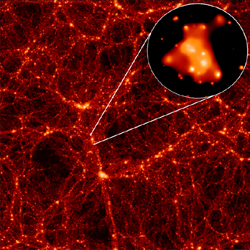April 8, 2005
RAS RELEASE PN 05/25

This image shows a computer simulation of a large volume of the Universe. An XMM-Newton X-ray image of a real galaxy cluster from the study is superimposed to illustrate the formation of galaxy clusters in the densest parts of the universe. (Credit: Virgo consortium; Reference: Jenkins et al. 1998)
Using two orbiting X-ray telescopes, a team of international astronomers has examined distant galaxy clusters in order to compare them with their counterparts that are relatively close by.
Speaking today at the RAS National Astronomy Meeting in Birmingham, Dr. Ben Maughan (Harvard-Smithsonian Center for Astrophysics), presented the results of this new analysis.
The observations indicate that, despite the great expansion that the Universe has undergone since the Big Bang, galaxy clusters both local and distant have a great deal in common.
This discovery could eventually lead to a better understanding of how to "weigh" these enormous structures, and, in so doing, answer important questions about the nature and structure of the Universe.
Clusters of galaxies, the largest known gravitationally-bound objects, are the knots in the cosmic web of structure that permeates the Universe. Theoretical models make predictions about the number, distribution and properties of these clusters.
Scientists can test and improve models of the Universe by comparing these predictions with observations. The most powerful way of doing this is to measure the masses of galaxy clusters, particularly those in the distant Universe. However, weighing galaxy clusters is extremely difficult.
One relatively easy way to weigh a galaxy cluster is to use simple laws ("scaling relations") to estimate its weight from properties that are easy to observe, like its luminosity (brightness) or temperature. This is like estimating someone's weight from their height if you didn't have any scales.
Over the last 3 years, a team of researchers, led by Ben Maughan, has observed 11 distant galaxy clusters with ESA's XMM-Newton and NASA's Chandra X-ray Observatory. The clusters have redshifts of z = 0.6-1.0, which corresponds to distances of 6 to 8 billion light years. This means that we see them as they were when the Universe was half its present age.
The survey included two unusual systems, one in which two massive clusters are merging and another extremely massive cluster which appears very "relaxed" and undisturbed.
The X-ray data allowed the scientists to measure the temperatures and luminosities of the gas in the clusters. They were then able to infer their total masses, which varied between 200 and 1,100 times the mass of our Milky Way galaxy.
These measurements were then used to test whether galaxy clusters of different sizes and located at different distances from us are simply scaled versions of each other -- a condition known as being "self-similar." This is an important characteristic for astronomers to identify if they hope to get the true weights of galaxy clusters.
"For example, chocolate bars are strongly self-similar," said Maughan. "If you shrank a king-size bar to a fun-size bar, they would be identical versions of each other but just different sizes."
"However, if you shrank a castle to the size of a bungalow, they would be very different structures, despite being the same size. This means that they are not strongly self-similar objects."
Another possible type of relationship between clusters is what scientists call "weakly self-similar." In this case, galaxy clusters in the distant universe and those nearby are almost identical to each other, but not exactly the same. (The only differences between them can be accounted for by the expansion of the Universe since the Big Bang.)
Although astronomers have known for some time that galaxy clusters are not strongly self-similar, the question of whether or not they are weakly self-similar has remained open.
The new results show that as long as astronomers take into account the continuous expansion of the Universe, then galaxy clusters are, in fact, weakly self-similar. This means that the same scaling relations used to weigh nearby galaxy clusters hold true for these very distant clusters.
"Our results mean that weighing distant galaxy clusters could become as easy as converting from Fahrenheit to Celsius," said Maughan. "This will help to answer important questions about the nature and structure of the Universe."
The other members of the team were: Laurence Jones (University of Birmingham, UK) Harald Ebeling (Institute for Astronomy, HI, USA), and Caleb Scharf (Columbia Astrophysics Laboratory, NY, USA).
The observations were made with the European Photon Imaging Camera (EPIC) on XMM and the Advanced Camera for Imaging and Spectroscopy (ACIS) on Chandra. They were part of the WARPS survey of distant galaxy clusters detected by chance in observations made with the UK-US-Dutch ROSAT X-ray satellite.
Additional information and images are available at:
MEDIA CONTACTS
Peter Bond
Phone: +44 (0)1483-268672
Anita Heward
Phone: +44 (0)1483-420904


